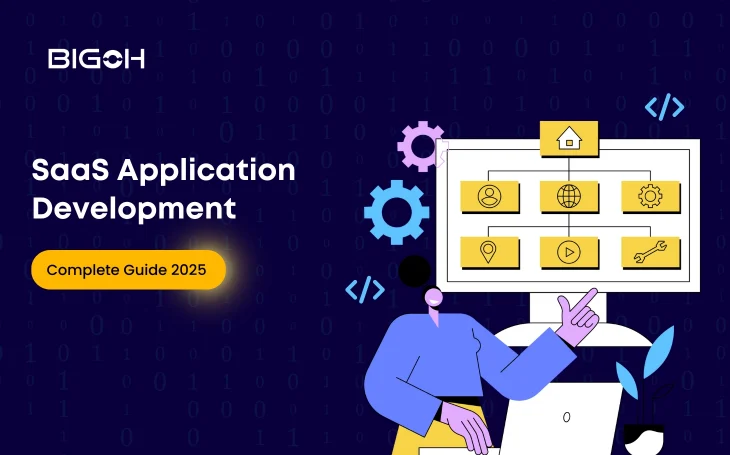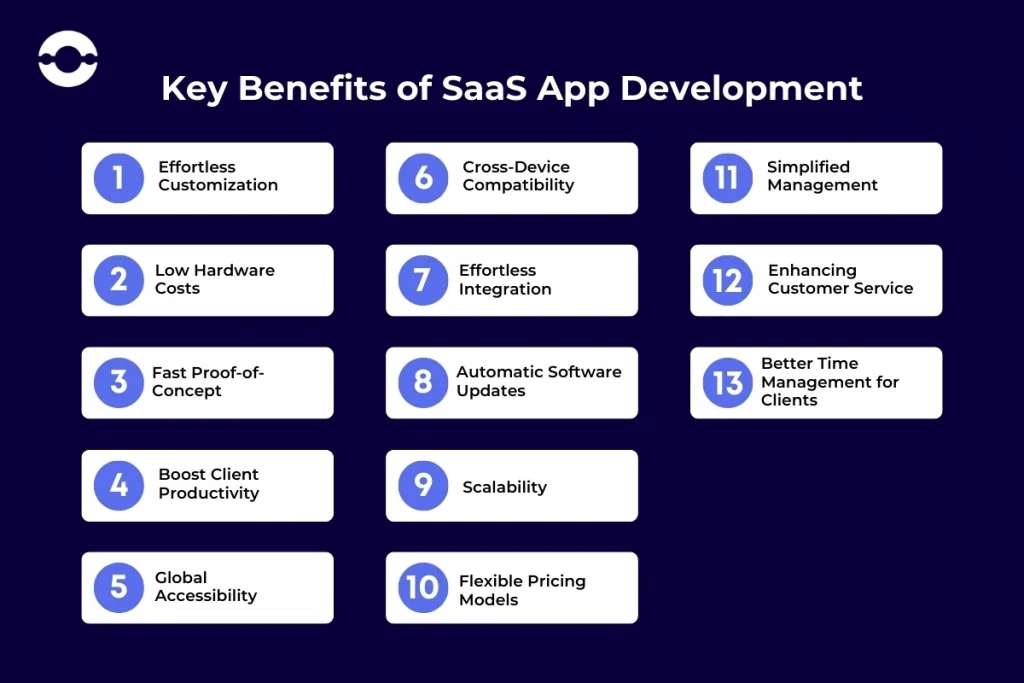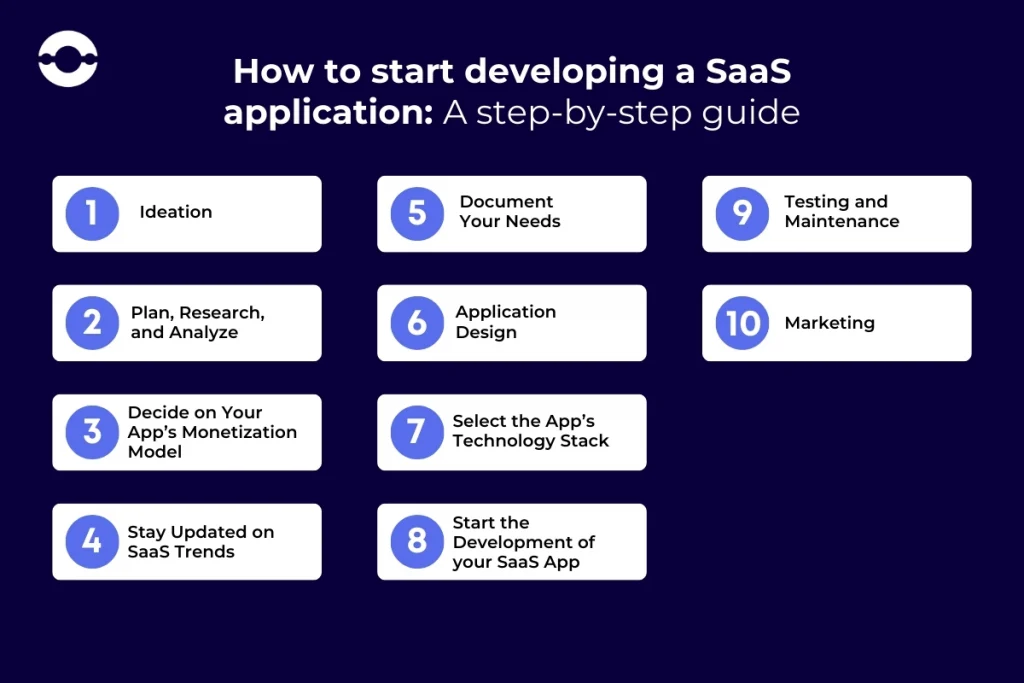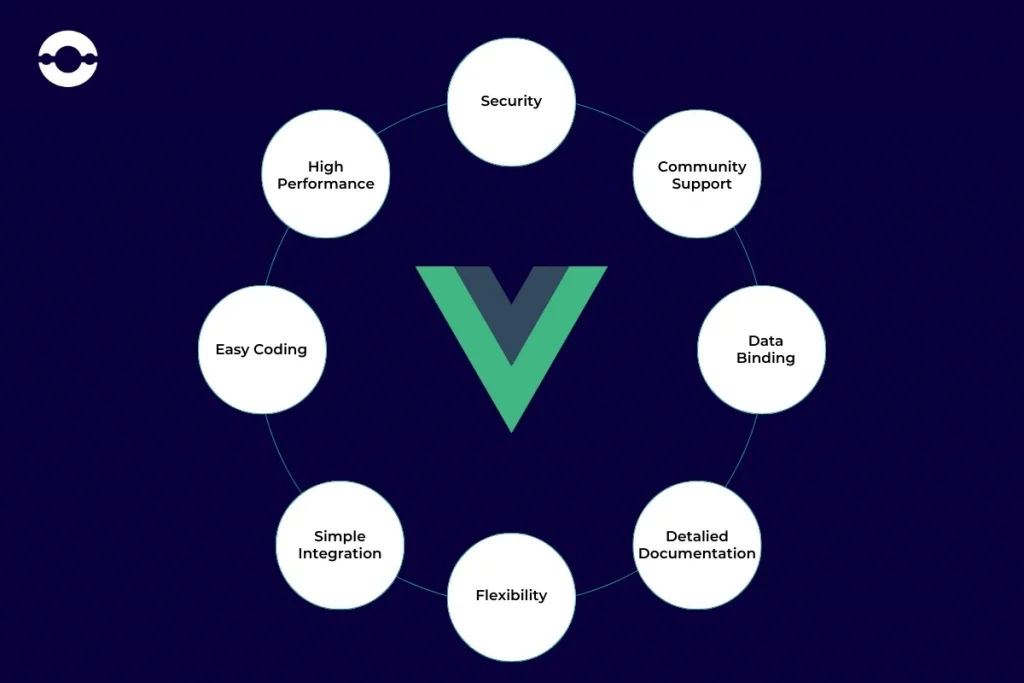
In today’s fast-paced digital world, Software-as-a-Service (SaaS) is more than just a trend—it’s a revolution, it’s the backbone of modern business solutions! Whether you’re a startup looking to scale or an enterprise aiming for agility, SaaS offers the perfect blend of flexibility, cost-effectiveness, and innovation.
But where do you start? How do you ensure your SaaS application not only meets but exceeds user expectations in 2025? Cause, it’s not just about staying on top of trends—it’s about anticipating user needs and building solutions that evolve with them.
So, in this guide, we’ll walk you through every aspect of SaaS application development, from the initial brainstorming session to the final deployment. Let’s break down the complexities and build a seamless experience, together.
So, what exactly is SaaS? Here’s a precise explanation
Software as a Service (SaaS) is a software delivery model where software is hosted on external servers and accessed online via a subscription. Instead of installing software on your own servers or computers, SaaS applications run in a cloud environment. This makes them easily accessible from anywhere with an internet connection.
In many cases, an independent software vendor (ISV) will hire a third-party cloud provider to host the application, while in other cases, larger companies like Microsoft might serve as both the vendor and cloud provider.
SaaS is particularly popular with small and medium-sized businesses because it offers a cost-effective alternative to traditional, in-house software. In fact, by 2025, 85% of all business applications are expected to be SaaS-based.
Commonly referred to as
- Web-based software,
- On-demand software,
- Hosted software,
SaaS solutions don’t require installation or maintenance on the user’s part. Everything, including updates and data backups, is handled by the provider. This allows businesses to focus on their core activities rather than dealing with IT infrastructure and software management.

Developing a SaaS application reduces the financial burden of expensive software by covering various business needs such as payroll, HRM, office suites, CRM, and other resource planning tools. In larger organizations like Microsoft, the cloud provider may also double as the software vendor, simplifying the process even further.
SaaS Growth Trajectory: A snapshot of its explosive expansion
The rise of Software as a Service (SaaS) has been nothing short of phenomenal. Let’s dive into the numbers and key statistics that highlight the rapid growth of this game-changing industry:
- Massive Market Size: In 2023, the global SaaS market was valued at a staggering $273.55 billion. But that’s just the beginning. Projections show that by 2024, this figure will jump to $339.10 billion, and by 2029, it will skyrocket to an incredible $818.80 billion, reflecting a CAGR of 19.28% over the forecast period (2024-2029). This is clear evidence of SaaS’s ever-growing demand and its bright future.
- North America Leads the Way: In 2023, North America alone accounted for $131.18 billion of the global SaaS market. This region remains the powerhouse behind the SaaS boom, thanks to the dominance of U.S.-based companies and their rapid adoption of cloud-based solutions.
- Thousands of Companies, Millions of Customers: There are currently over 30,800 SaaS companies worldwide, serving millions of users globally. Not surprisingly, the United States takes the lead with over 17,000 SaaS providers.
- Tech Giants Driving Innovation: Some of the major names in SaaS include Google Cloud Marketplace, Google Workspace, Amazon Elastic Compute Cloud, Microsoft Cloud, and IBM Cloud Integration. These industry leaders continue to push boundaries and set new standards for what SaaS can achieve.
- Salesforce: The SaaS Giant: Sitting at the top of the SaaS pyramid is Salesforce, the world’s largest SaaS company. In 2024, Salesforce generated a mind-blowing $34 billion in revenue.

Key architectural categories of SaaS
When it comes to SaaS, the architecture you choose plays a huge role in how your cloud-based applications are built, deployed, and ultimately delivered to your customers. Each architectural model has its own strengths, designed to meet different needs based on factors like tenancy, frameworks, and functionality.
When discussing SaaS app development, you’ll often hear the terms horizontal and vertical. These two categories define how SaaS solutions are structured and whom they serve.
So, let’s break down this key architecture which is moreover, segregated by functionality and industry:
1. Horizontal SaaS
Looking to create a SaaS app that serves a wide range of industries? Horizontal SaaS solutions are the way to go. These platforms are designed to meet common business needs, such as streamlining operations and boosting productivity. Think of tools like Salesforce or Google Workspace that cater to multiple sectors.
2. Vertical SaaS
If your goal is to build a SaaS application tailored to a specific industry or niche, vertical SaaS is your answer. These products focus on industry-specific challenges, whether it’s healthcare, retail, or finance. For example, Veeva serves the life sciences industry, while Shopify caters to e-commerce.
Exploring the Types of SaaS Applications: What Fits Your Business Needs?

SaaS applications are incredibly diverse, serving both businesses and individuals across many domains. Let’s break down the most common types of SaaS apps, each designed to tackle different challenges:
1. Productivity and Collaboration Tools
Think of cloud-based word processors, spreadsheets, and project management platforms. These tools streamline workflows, help teams track tasks, and cut down on miscommunication. Ever heard of Trello, Asana, or Google Workspace? They’re all about making teamwork smoother!
2. Customer Relationship Management (CRM) Software
Need to manage sales, customer interactions, and data in one place? CRM solutions like Salesforce or Hubspot do just that! They automate tasks, provide advanced analytics, and even predict customer behaviour—helping businesses close deals faster.
3. Enterprise Resource Planning (ERP) Systems
These platforms bring together essential business processes like accounting, HR, and inventory. Big names like SAP and Oracle help businesses stay organized and efficient by managing everything under one roof.
4. Content Management Systems (CMS)
Want to build a website without needing a development team? CMS platforms like WordPress and Shopify make it easy for businesses to create and manage websites, offering powerful tools even for non-technical users.
5. Human Resources Management Software:
From onboarding to payroll, SaaS HR tools like Workday and BambooHR handle all things employee-related. They help organizations streamline their HR processes and keep everything running smoothly from hire to retire.
6. Business Intelligence and Analytics:
Need insights fast? SaaS tools like Tableau and Power BI provide advanced data visualization and analytics to help businesses make smarter, data-driven decisions.
7. Billing and Invoicing Tools
Accounting and billing software, such as Xero and QuickBooks, automate financial processes. These tools generate invoices, track payments, and keep your finances in order with minimal effort.
8. Communication Software
In a remote work era, tools like Zoom, Slack, and Microsoft Teams have become essential for staying connected. Whether it’s video conferencing or team chats, these apps ensure smooth communication across borders.
9. Industry-Specific Applications
Some SaaS apps cater to niche industries. For example, Veeva serves life sciences, Yardi helps with property management, and Shopify powers online stores. These tailored solutions make industry-specific challenges a breeze to manage.
Key Benefits of SaaS App Development: A Closer Look

How a SaaS application developement can benefit both you as a business owner along with your clients has been highlighted below:
1. Effortless Customization
One of the standout perks of building a SaaS platform is how easy it is to customize for your clients. You’re not dealing with complex, outdated systems; instead, your software adapts to their specific needs. And since everything’s hosted online, making real-time updates or offering tailored solutions is a breeze. Whether they need feature tweaks or major upgrades, your product can evolve as they do.
2. Low Hardware Costs
For your clients, SaaS means they no longer need to spend on expensive hardware. Everything runs in the cloud, managed by you. No need for massive server setups or hardware upgrades. This gives your business an edge—clients are more likely to choose your SaaS solution because it saves them money and tech headaches.
3. Fast Proof-of-Concept
As an entrepreneur, you can quickly deploy proof-of-concept (PoC) tests for potential customers. They get to see how your software will work for their business before fully committing. With this approach, you’re showing value upfront—allowing them to experiment with flexible versions and discover which features suit their needs best, making them more likely to convert into paying customers.
4. Boost Client Productivity
By providing a SaaS product, you help businesses focus on what they do best while your software handles routine tasks—think bookkeeping, payroll, or even customer service. For your clients, this translates into a productivity boost, allowing them to streamline their operations while your SaaS takes care of the backend tasks. And for you, it means you’re delivering real value that keeps clients coming back.
5. Global Accessibility
One major selling point for your SaaS platform? It’s accessible from anywhere. Whether clients are in the office, at home, or traveling, they can access your product as long as they have an internet connection. This is especially beneficial in today’s world where remote work is on the rise—giving your business a competitive edge in providing global accessibility.
6. Cross-Device Compatibility
Your SaaS app isn’t tied to any single device. Whether clients are using a desktop, tablet, or smartphone, they can seamlessly switch between them. This flexibility means your product will fit into their workflow, wherever they are. And the easier it is for them to use, the more likely they’ll stick with it.
7. Effortless Integration
Thanks to APIs, your SaaS platform can integrate smoothly with other systems your clients are already using. This is a huge selling point. Instead of forcing them to overhaul their current tools, you’re adding value by ensuring your software fits into their ecosystem with minimal disruption.
8. Automatic Software Updates
One of the big pain points with traditional software is keeping it up to date. With SaaS, you handle all the updates, ensuring your clients always have access to the latest features and security patches. They don’t have to worry about downtime or out-of-date systems, which means you’re offering them peace of mind.
9. Scalability
As your clients grow, so can your SaaS solution. Need more storage or extra features? No problem—it’s as simple as upgrading their plan. This flexibility allows you to cater to businesses of all sizes, from startups to large enterprises, without requiring them to make significant infrastructure changes.
10. Flexible Pricing Models
Offering subscription-based pricing gives you and your clients flexibility. They don’t need to commit to expensive, one-time purchases, and you get a steady stream of revenue through recurring payments. Plus, the ability to scale pricing based on their needs makes it easier to attract a wider range of customers.
11. Simplified Management
With SaaS, you handle the tech, so your clients don’t have to. Any issues are managed through SLAs (service-level agreements), keeping you accountable for resolving problems quickly. This takes a huge burden off your clients’ shoulders and strengthens your reputation as a reliable provider.
12. Enhancing Customer Service
Developing a SaaS product lets you build in customer service features that make life easier for your clients. Automated updates, real-time notifications, and seamless new features mean their experience with your software is consistently positive. This not only boosts customer satisfaction but also leads to higher retention rates.
13. Better Time Management for Clients
When you provide your clients with a SaaS solution, you’re helping them manage their time better. From project management tools to team collaboration features, your product streamlines their processes, helping them meet deadlines and optimize workflows. And that’s exactly what businesses look for—tools that make their lives easier.
How to start developing a SaaS application: A step-by-step guide

Building a SaaS application can feel like a big task, but breaking it down into steps makes it much more manageable. Let’s walk through the 10 steps of SaaS development in a very simplified manner.
Step 1: Ideation
Got an idea for a SaaS product? Great! This is the fun part where you brainstorm. Think about what problem your app will solve, who will use it, and what unique features will make it stand out. It’s okay if things feel a little hazy at first—this is the time to get creative. You can also bring in a SaaS development company to help guide the process.
Step 2: Plan, Research, and Analyze
Now, it’s time to get serious. Research your target market, check out what competitors are doing, and plan your approach. What technologies do they use? How do they engage users? This step sets the foundation for your app, so dive deep.
Step 3: Decide on Your App’s Monetization Model
How will your app make money? Subscription-based? Pay-as-you-go? Freemium? The revenue model will shape your app’s features and architecture, so give it careful thought. It’s not just about making money, but making sure users feel they’re getting real value.
Step 4: Stay Updated on SaaS Trends
To make your app relevant, you need to know the latest SaaS trends. What are users excited about right now? Maybe it’s AI integration, seamless UX, or better data security. Keep your finger on the pulse so your app stays fresh and valuable.
Step 5: Documentation Design
Your app should be both functional and attractive. Design a clean, intuitive interface that makes the user experience (UX) smooth and enjoyable. A good-looking app that’s hard to use won’t get much love, so balance the visuals with usability.
Step 7: Select the App’s Technology Stack
Choosing the right tech stack is crucial.
- For backend: Developers often use Ruby, Python, PHP, or JavaScript frameworks.
- For frontend: You’ll need HTML, CSS, and JavaScript frameworks like Vue.js or Angular.
- For databases: MySQL, MongoDB, and PostgreSQL are popular choices.
Keep in mind the scale of your project and how these technologies will integrate with other systems.
Step 8: Start the Development of your SaaS App
Now, it’s time for the actual work to be done. Make sure your team members are aligned with the goal and vision. Start coding your app based on the documented requirements. Don’t hesitate to seek guidance from freelancers in case you’re a newbie or if your team faces a bump in the road.
Step 9: Testing and Maintenance
Your app is built—now what? Time for rigorous testing. The team now needs to check every corner to ensure the SaaS application works smoothly. After that, ongoing maintenance is key to keeping your app running efficiently.
Step 10: Marketing
Start marketing early, even before your app is finished. Create buzz around your SaaS product, build a landing page, and get people excited. Take a page from Dropbox’s book—they used a simple landing page and collected email addresses, building anticipation long before launching.
How much does it cost to build a SaaS application? Here’s a breakdown:
When it comes to building a SaaS application, the cost can vary a lot depending on several factors like complexity, features, and team structure. Let’s walk through some estimates and key aspects that influence the final price.
General Cost Overview
For a minimum viable product (MVP), the typical development cost ranges from $50,000 to $150,000. If you’ve allocated $100,000 for marketing, your yearly maintenance budget should be at least $25,000. But why such a range in costs? Let’s take a closer look.
Key Factors That Impact SaaS Development Costs:
1. Complexity of Features: The more complex your app’s features are, the higher the cost. For instance, adding advanced analytics, AI integrations, or custom dashboards will increase your budget.
2. Development Stages: From planning to launch, each development stage takes time and resources. More time means higher costs, especially for testing, debugging, and polishing the app.
3. Type of Solution: Are you building a simple Micro SaaS, or a more robust and feature-rich platform? The type of solution you want will heavily impact the price.
4. Team Structure: Outsourcing to countries with lower labor costs can significantly reduce your budget, but in-house teams offer more control over the process.
5. Geographical Location: Where your development team is located plays a huge role in cost. For instance, developers in the United States will cost much more than those in India.
Read Also – Ultimate Guide to Hire a Full Stack Developer in 2025
How Much Does It Cost to Create SaaS based Development?
Micro SaaS Development: ($13,000 to $25,000) Perfect for a small, focused app with limited features. Ideal for niche markets.
Basic SaaS: ($20,000 to $80,000) A standard SaaS application with essential features and a simple interface.
Average SaaS: ($80,000 to $150,000) Includes more customization, features, and third-party integrations.
Complex SaaS: ($150,000 to over $300,000) Feature-rich, scalable, and possibly designed for enterprise-level solutions.
How Long Will It Take to Build Saas Development?
Building a SaaS app takes time, and it varies depending on the complexity. Here’s a rough breakdown:
- Validation and Planning: 40 to 250 hours
- Creating MVP or Proof of Concept: Over 350 hours
- UI/UX Design: 120 to 250 hours
- Front-End Development: 400 to 600 hours
- Back-End Development: Up to 800 hours
- Project Management & Post-Launch Maintenance: Ongoing, depending on the brand and app needs.
Geographical Cost Breakdown
Here’s an estimation of the cost to build a SaaS application based on where your development team is located:
| Country | Cost |
| United States | $300,000 |
| United Kingdom | $250,000 |
| West Europe | $200,000 |
| East Europe | $150,000 |
| India | $6,500 |
Before diving into development, it’s critical to budget smartly and know what you’re aiming for. Whether you’re building a micro-SaaS app or a complex enterprise solution, being aware of the costs and timelines will help you plan effectively.
Adopting the Right Framework for SaaS
Choosing the right framework for your SaaS application development is crucial to the success of your application. By picking the right framework, you’ll set a solid foundation for building a scalable, secure, and user-friendly SaaS application. But before choosing, here are some of the key parameters you need to consider:
- Scalability
Your app should grow with your business. Choose a framework that supports smooth scaling to avoid roadblocks as your user base expands.
- Security
With a 95% increase in cloud exploitation last year (CrowdStrike 2023), security is non-negotiable. Look for frameworks that come with built-in security features like authentication, encryption, and access control to keep your app and users safe.
- Programming Language
A framework built on an easy-to-learn language speeds up development. The faster your team adapts, the quicker they can start building.
- Integration
Pick a framework that plays well with your existing tech infrastructure, minimizing the need for extensive modifications.
- Community Support
A strong developer community ensures you can find help when needed, making problem-solving much easier.
- Cost
Some frameworks are free, while others require licenses. Weigh the costs against your budget as they can impact your development timeline and roadmap.
Some of the notable frameworks to build your SaaS application comprise:
- Laravel (PHP): A simple, elegant framework with built-in support for SaaS apps, offering features like authentication and database management.
- Django (Python): Known for its scalability and speed, Django provides a robust toolkit for developing complex, secure applications.
- Meteor (JavaScript): A full-stack framework with real-time communication, ideal for fast SaaS app development.
- Angular (JavaScript): Google’s framework for building dynamic single-page applications (SPAs) with a modular structure.
- React (JavaScript): A flexible library for creating fast and interactive user interfaces, often paired with other stacks for full SaaS apps.
- Ruby on Rails (Ruby): Focuses on convention over configuration, making it easy to build scalable and maintainable web apps.
- Symfony (PHP): Modular and organized, Symfony provides reusable components for building robust SaaS applications.
- Docker: Helps in deploying SaaS apps in lightweight containers, ensuring consistent environments across platforms.
- Node.js (JavaScript): Ideal for building high-performance, scalable apps due to its non-blocking, event-driven model.
- Vue.js (JavaScript): A flexible front-end framework that simplifies building and managing complex UIs.

SaaS Application Pitfalls: Avoid These Common Mistakes
Developing a SaaS application comes with its own set of challenges, and avoiding some common missteps can make a huge difference in your success.
Insufficient Market Research
Skipping the deep dive into your target market is a big no-no! Before launching, really get to know your audience, understand what your competitors are doing, and confirm that there’s demand for your app. Trust me, thorough research now will save headaches later.
Random Pricing Decisions
Pricing your SaaS product is not a guessing game! It’s about crunching the numbers—study your competitors, weigh different pricing models, and calculate the return on investment for your users. Nail this step, and you’ll avoid awkward conversations about cost down the road.
Skipping the MVP
It’s tempting to add all the features right away, but hold off! Start with a Minimum Viable Product (MVP) to test the waters. It’s much easier to adjust when you’re working with user feedback on a lean, focused product.
Ignoring User Feedback
Got feedback? Don’t let it sit idle. Your users are your biggest resource, so act on their suggestions quickly. Continuous improvement based on real feedback is the key to a thriving app.
Overlooking Scalability
Picture this: your app goes viral, but your servers can’t keep up. Disaster, right? Plan for growth from day one, ensuring that your app scales effortlessly, no matter how many users flood in.
Skipping Tutorials
Ever been excited about a product, but completely lost on how to use it? Don’t let that happen with your app. Provide clear, accessible tutorials—whether through blogs, videos, or e-books—to make sure users can onboard with ease.
Weak Security Measures
Security is a dealbreaker. If your app isn’t rock solid from a security standpoint, you’re opening yourself up to big risks. Build security into your app right from the start, and keep refining it with regular audits.
No Marketing Strategy
It’s not enough to rely on word-of-mouth. Create a marketing game plan that includes digital strategies, content creation, and social media buzz. You need to get your product in front of the right people!
Inadequate Customer Support
Your users will have questions, and how you handle them can make or break their experience. Set up a robust customer support system with FAQs, live chat, and responsive email options to keep users happy.
Ignoring Analytics
Analytics tools give you the insights you need to understand user behavior and make smart decisions for the future.
Neglecting Compliance
Regulations and compliance standards aren’t optional. Make sure your app checks all the boxes on data protection laws and industry standards to avoid trouble down the line.
Conclusion
Building a SaaS application may feel like a long and winding road, but with the right approach, you’re already well on your way to success. Now that you’re equipped with the complete guide, it’s time to roll up your sleeves and bring your idea to life.
BigOhTech specializes in crafting innovative, industry-ready, secure and scalable SaaS applications with 3x lower cost. Let’s chat and explore how our team of over 100 experts can guide you in building something amazing, together.




